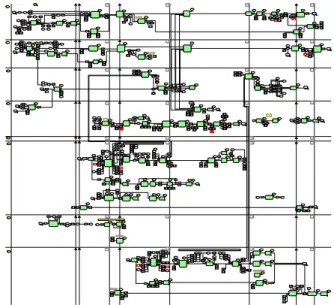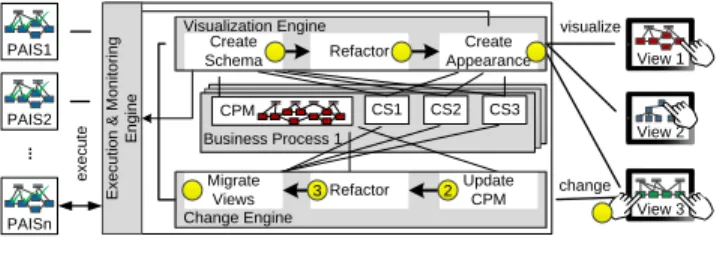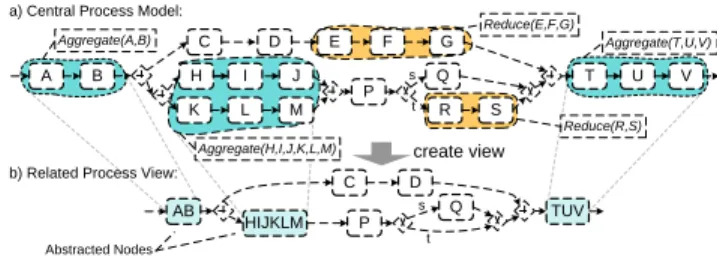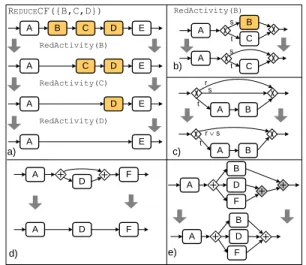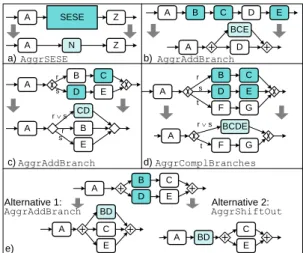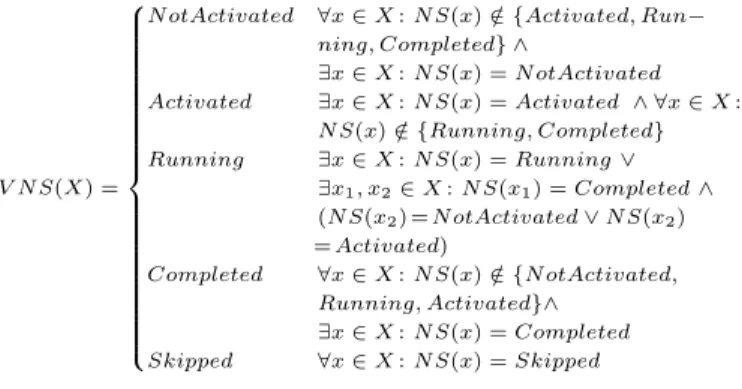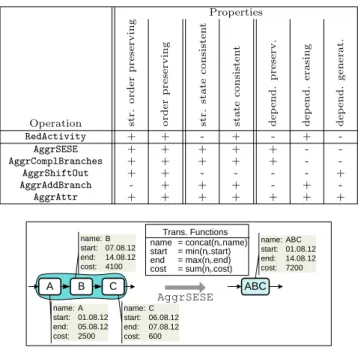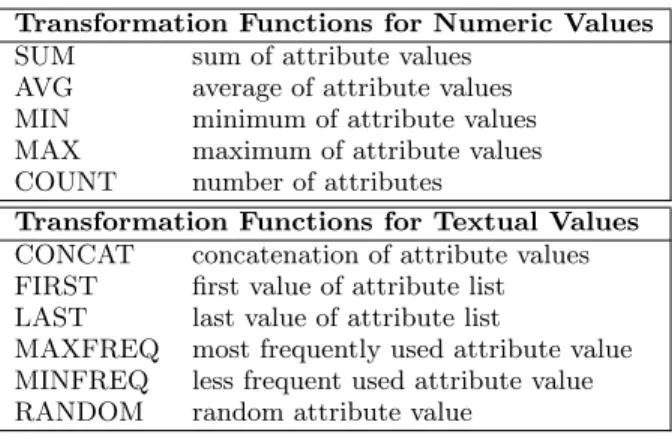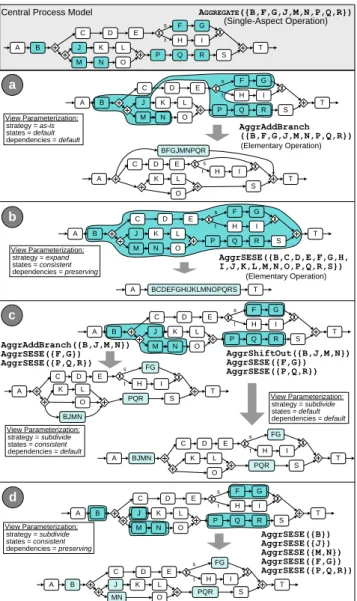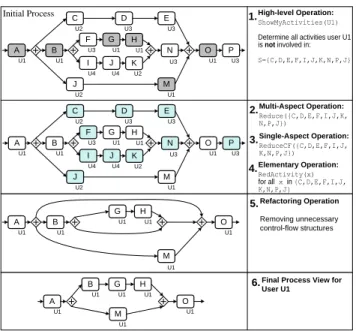A Flexible Approach for Abstracting and Personalizing Large Business Process Models
Jens Kolb
Ulm University, Germany
jens.kolb@uni-ulm.de
Manfred Reichert
Ulm University, Germany
manfred.reichert@uni-ulm.de
ABSTRACT
In process-aware information systems (PAISs), usually, dif- ferent user groups have distinguished perspectives on the business processes supported and on related business data.
Hence, personalized views and proper abstractions on these business processes are needed. However, existing PAISs do not provide adequate mechanisms for creating and visualiz- ing process views and process model abstractions. Usually, process models are displayed to users in exactly the same way as originally modeled. This paper presents a flexible approach for creating personalized views based on param- eterizable operations. Respective view creation operations can be flexibly composed to either hide non-relevant process information or to abstract it. Depending on the parameter- ization of the selected view creation operations, one obtains process views with more or less relaxed properties, e.g., re- garding the degree of information loss or the soundness of the resulting model abstractions. Altogether, the realized view concept allows for a more flexible abstraction and vi- sualization of large business process models satisfying the needs of different user groups.1
Categories and Subject Descriptors
D.2.2 [Design Tools and Techniques]: Computer-aided software engineering (CASE); H.1.2 [User/Machine Sys- tems]: Human factors
General Terms
Management, Design, Human Factors
Keywords
Process Model Abstraction, Process View, View Update, Process Visualization, Human-oriented Business Process Man- agement, Process Change
1. INTRODUCTION
Process-aware information systems (PAISs) provide support for business processes at the operational level [1]. A PAIS strictly separates process logic from application code, rely- ing on explicitprocess models. This enables aseparation of concerns, which is a well established principle in computer
1Copyright is held by the authors. This work is based on an earlier work: SAC’12 Proceedings of the 2012 ACM Symposium on Applied Comput- ing, Copyright 2012 ACM 978-1-4503-0857-1/12/03.
http://doi.acm.org/10.1145/2245276.2232043
science to increase maintainability and to reduce costs of change [2]. The increasing adoption of PAISs has resulted in large process model collections (cf. Figure 1). In turn, each process model may refer to different domains, orga- nizational units, and user groups, and comprise dozens or even hundreds of activities (i.e., process steps) [3]. Usually, different user groups need customized views on the process models relevant for them, enabling a personalized process model abstraction and visualization [4, 5, 6, 7]. For exam- ple, managers rather prefer an abstract process overview, whereas process participants need a more detailed view of the process parts they are involved in.
PMS4: Large Process Model Illustration.
One of our partners from the automotive domain has provided us with detailed insights into product planning (PP), which constitutes a core process in vehicle development [1]. The part of the PP process we considered, for example, comprises a large number of activities for planning production facilities and resources. Furthermore, it defines the flow of about 50 relevant documents. When studying this case we got access to a large model that was plotted on a 1,5 m x 5 m wallpaper - a fragment of this process is depicted in Fig. XX1. Altogether, the PP process comprises several hundreds activities with complex inter-dependencies. Furthermore, there exists a process handbook with detailed descriptions of each activity. This handbook mainly serves for training purposes and provides detailed task descriptions. – From interviews with process owners we have learned that the current model contains several flaws, is known in its complete form to only very few experts, and is outdated in certain parts.
In particular, the model is considered as being too large and costly regarding its maintenance.
Interestingly, due to an enterprise-wide harmonization initiative the current process model needs to be transformed into another notation as well as into a more comprehensible form.
...
........................................
.. ... ...
...
... ...
...
... ..
...
. ...
...
.. ...
...
... ....
...
... ...
...
...
...
. ... ...
... ...
... ...
... ...
.
... ...
...
...
.. ... ... . ...
... ..
...
.. .... .........
... ...
... ...... ...
...
... ...
...
...
.........
... ...
... ...
... ... ...
... ...
... ...
... ...
...
.... ...
.
... ...
.
...
... ... ...
......
...
...
.. ...
...
...
...
.........
... ...
... ...
... ...
... ... . ... ...
... ...
... ..... ... ...
... ... ....
... ...
... ...
... ...
... ...
... ...
... ...
... ...
......
...
... ... ...
.. ... ...
... ... ...
... ... ...
... ...
... ... ...
... ... ...
... . ... ...
... ...... ... ... ...
... ... ...
... ...
...
............
... ...
... ...... ... .
... ...
... ... .
... ... ...
... ...
...
...
...
...
......
.... ... ...
... ...
... ...
... ... ...... ...
... ... ...
... ... ...
... ... ...
... ... ...
.... ... ...
... ...
...
...
...
... ... ...
... ... ...
...
...
...... ....
.
...
...
.
... ...
...
...
...
... ...
.. ... ...
... ... ...
... ...
... ...
.... ... ...
. ... ...
... ...
... ... ....
.... ... .
... ...
...
... ...
... ...
... ...
.. ... ..
...
... .
...
...
.... ...
...
.. ... ......
...
...
. .. .
... ....
.... ...
...
... ...
... ...
...
...
...
...
...
...
...... ...
... ... ...
... ...
... ...
...
...
...... . ...
...
...
...
...
... ...
.... ...
...
...
...
...
... ...
... ...
.... ...
... ...
...
...
...
... ...
... ...
... ...
... ...... ... ....
.. ... ..
... ...
... ...
...
... ... ...
.
...
.
...
... .
...
.
...
......
...
... ... ...
... ... ..
... ... ...
... ... ...
... ....
... ...
......
...
...
...
...
... ..
...
...
...
...
... ...
... ...
... ....
...
...
...
......
... ... ..
... ... ...
.. ... .
... ... ...... ...
... ... ...
. ... ...
... ...
... ... ...
... ... ...
... ...
...
...
...
... ... ...
... ... ...
... ...
... ....
...
...
... ..................
... ...
.... ... ...
... ... ...
.... ... ...
... ...
... ...
... ...
... ...
... ...... ... ....
... ... . ... ...
... ...
... ... ...
. ... ...
... ...
... ...
...
...
...
...
...
...
......
... ...
... ...
... ...
....
. ... ...
... ...
.. ... ...
... ...
... ...
... ...
......
......
... ... ...
... ...
... ...... ...
...
... ...
... ... ...
... ...
... ...... ...
... ...
.... ...
... ...
.
... ...
...
... ...
...
...
...
...
...
...
...
...
... ... ..
... ...
... ...
... ...
... ...
... ...
... ...
... ...
... ...
.... ...
... ...
... ...
... ...
.... ...... ...
... ...
...
... ... ...
.. ...
...
... ...
...
...
.... ...
... ...
...
...
...
...
...
...
... ...
... ...
... ....
...
...
...
......
... ...
... ...... ... ...
... ...... ... ...
... ...
... ...
... ...
... ...
... ...... ...
... ...... ... ...
...
...
...
...
...
... ...
...
. ...
.
...
...
... ...
... ...
...
... ...
...
...
... ...
......
...
... ... ....
... ...
... ...
... ... . .... ...
... ...
.
. ...
... ...
...
......... ...
...
...
... ...
...
......
......
... ... ...
... ... ...
... ... . ... ...
...
... ... ..
.. ...
... .........
...
. ...
...
...
...
.
... ... ... ...
.
... ...
.
... ...
.
... ...
...
.
...
...
.
... ...
.
... ...
...
.......
...
...
............
... ...
.... ... ...
... ... ...
.... ... ...
... ...
... ...
... ...
... ...
... ...
... ... ...
... ... . ... ...
... ....
... ... ...
. ... ...
... ....... ...
...
.. . ...
...
.. ...
...
...
... ... ...
... ... ...
... ... ... ...
... ...... ...
... ... ... ...
. ... ...
.... ... ... ...
... ...
... ... ...
... ...
...
...
...
...
... ... ...
...
...
. ...
...
... ... ...
...
.... ... ...
. ... ...
....
... ....
...
.
... ...
.
...
.
... ...
... ...
...
.
...
...
...
......
...
...
...
...
.
... ...
... ...
... ....
... ....
... .
...
...
......
.. ... ...
... ...... ... ..
... ...
... ...
... ...
... ...
... ... ...
... ...
... ... ... ...
... ... ...
...
...
...
...
... ... ...
... ... ...
. ... ... ...
... ...
... ...... ... ... ...
... ...... ... ...
... ...... ... ...
. ...
...
...
...
...
...
... ...
... ...
... .
... ...
... ... ....
... ...
... ...
.. ...
... ..... ...
... ...
... ...
...
...
...
...
... ... ..
...
... ...
...... .
... .
...
...
... ... ...
...
...
...
... ...
... ...
... ...
... ...
...
...
...
...
. ...
...
...
...
... ... ... ... ...
.
...
... ... ...
... ...
...
.... ...
...
...
... ...
... ...
... ...
... ... ...
... ...
... ...
... ...
... ...... ... ...
... ... ...
.... ... ...
... ... .
... ...
... ... ...
... ...
... ...
... ...
...
...
...
...
... ...
... ... ...
... ...
... ...
... ...
... ...
... ...
.
...
...
...
...
...
.. ... ...... ... ...
... ... ....
... ...
... ... ...... ... ... ...
... ... ....
... ...
... ... ...
...
...
...
......
... ...
... ...
... ...
... ...
... ... ...
... ...
...
...
...
.
...
...
...
...
...
... ...
... ... ...
... ... ....
... ...
... ...
.. ... ...
... ... ...
... ...
... ... ...
... ...
... ...
... ...
... ... ...
... ...
... ... ... ...
... ...
... ... ...
... ...
... ...
... ...
. ... ...
...... ... ....
.
...
...
...
.
...
...
...
...
...
...
... .
... ...
... ...
... ...
...
...
...
...
... ...
... ...
... ...
... ...
... ...
... ...
... ...
... ... ...
...
...
...
...
.... ... ...
... ...
... ... ...
... ... ...
... ...... ... ...
.... ... ...
...
...
...
... ... ....
... ...
...
...
...
...
... ...
...
...
.
... ...
... ...
...
...
...
...
... .
... ... ... ... ...
...
...
...
...
... ...
.. ... ...
. ... ...
... ... ...
... ... .
... ... . ... ...
...
...
...
...
...
... ...
... ...
...
... ...
...
...
...
...
... ... .... ... ...
... ...
..
... ... ... ... ...
... ...
...
...
...
...
. ...
... ...
.
... ....
... ...
...
. ... ...
...
...
.
. ...
...
... ...
.
... ...
...
...
.
...
... ....
...
...
...
......... ...
.
...
.
... ...
...
.....
. ...
... ...
... ... ...
......
... ..... ...
...... ...
...
...
......
.
... ...
...
... ..
...
...
...
...
... ... ...
...
...
...
... ...
... ... ..... ...
... ...
......
...
...
... ... ...
.... ... ... ...
... ... ... ...
... ...... ... ... .
... ... ... ...
... ... ... ... ...
... ... ...
... ... ... ....
... ...
... ... ...
... ...
... ...
... ... ... ... ...
... ... ... ...
... ...
... .
...
...
.
. ...
...
.
...
...
... ...
...
...
...
...
...
...
...
... .
...
...
...
...
...
... ...
... ...
... ...
... ...
.. ... ...
.. ... ...
... ...
... ...
.. ...... ...
... ...
... ... ...
... ...
...
...
...
...
...
...
... ...
... ..
.
...
...
...
...
... ..
....
. ...
... ...
...
...
... ...
... ...
...
... ...
...
...
...
...
...
...
...
....... ...
.
.... ...
...
.
... ...
...
... . ... ... ...
... ...... ...
... ...
... ...
.
...
............
... ...
... ...... ...
... ...... ... ...
... ... ..
.. ... ...
... ... ...
... ...
... ... ....
... ...
...
... ...
...
...
...
. ...
... ... ...
... ...
... ...
... ...
... ...... ...
... ... ...
... ...
... ...... ...
... ...
... ...
... ... .
...
...
... ...
... ...
... ...
... ...
... ...
... ...
... ...
. ...
... ...
... ..... ... ...
... ... ...
... ...
.... ...
...
...
.........
... ... ...
... ...
... ...
... ... ..
... ...
... ... ...
... ....... ...
... ... ...
... ...
... ......
..
.........
...
... .........
.. ... ... ...
... ... ... ... ...
... ...
... ... ...
... ...
...
... ...
... ...
...
...
...
...
... ...
... ...
... ...
.... ...
... ... ...
. ... ...
... ... ..
... ...... ...
... ...
... .
...
. ...
...
...
... ...
...
... ...
... ...
...
...
...
... ...
... ..
...
... ...
... ..
... ...
...
...
...
...
...
... ... ... ...
... ... ... ...
... ... ...
... ...
... ...
... ...
... ...
... ...
...
.........
.... ... ...
... ...... ...
... ...
... ...
... ...
... ...
... ...
... ..
...
.... ...
... .
... ..
...
...
...
....
...
...
...
... ...
... ...
... ...
... ... ...... ...
... ... ...
... ... ...
... ..... ... ...
... ... ....
...
...
...
...
...
...
...
...
... ...
. ...
... ... . ... ... ...
... ... ...
. ......
...
... ..
...
...
......
... ...... ... ...
...
...
...
...
...
.. ... ....
...
...
......
......
... ...
... ...
... ..
... ...
... ...
... ...
... ...
... ...
... ...
...
...
.
...
... ....
... ...
...... ...
.. ...
... ....
... ... ...
...
.
... .
...
.
...
... ..
.
...
. ...
...
... ..
......
... .
...
...
...
... ...
... ... ...... ... ...
... ... ...
... ... ...
... ...
... ... ...
... ... ...
... ...... ... ...
.. ... ...... ... ... ...
... ... ... ...
.. ... ... ...
... ....... ... ...
... ... ...
... ... ...
... ...
...
.... ...
.
...
...
...
...
...
...
.
... ...
...
...
...
...
...
...
...
...
...
... ...
... ... ...
... ...
... ...
... ...
... ... ...
... .
... ...
... ...
... ...
... ... ...
... ...
... ... ..
... ...
... ...
...
...
.
...
...
.
...
...
... ..
...
.
... ... ...
...
...
...
...
... ...
... ...
... ...
.... ... ...
... ...
... ...
... ..
......
...
...
.
...
...
...
... .... ...
...
...
...
...
... ...
... ...
... ... ...
... ... ... ...
... ...
...
...
...
...... ....... ...
...
... .
...
..
... ...
...
...
...
...
...
... ...
... ... ...
... ... ...
... ...
... ...
... ... ...
... ...
... ...
... ...... ...
... ...... ... ...
.... ...
... ...
. ... ...
.
...... .
...
... .... ...
...
...
...
...
...
.........
...
...
...
...
.
... ...
...
.
... ...
. ...
...
......
... ...
... ...
.... ... ....
... ... ....... ...
... ...
... ...
... ...
. ... ...
... ...
... ...
... ...
...
...
...
... ...
...
... ...
... ...
...
...
... ...
... .
... ...
.. ...
... ...
... ... ... ... ...
......... ... ...
... ... ...
... ...
... ...
... ...
.... .... ...
...
... ....... ... ...
...
...
... ...
... ...
...
... ...
...
... ...
...
... ...
. ...
... ..
.. ...
... ...
...
... ...
.. ...
. ....
. ...
...
...
...
...
...
... ..
...
...
... ...
.... ..
...
...
... .
...
....
...
... ..
.... . .... ...
...
......
...
... ... ...
... ...
... ...
... ...
... ...
.... ...
... ...
... ...
.
...
...... ...
... ...
... ...
... ...
... ...
... ...
... ...
... ...
.... ... ...
... ... ...
... ...
... ...
... ...
.
...
...
...
.... ... ....
...
... ...
... ...
...
...
......
... ...
... ... ...
... ...
... ...
... ...
... ...
... ...
... ...
... ...
... ...
...
...
...
... ...
... ...
...
...
...
...
...
... ...... ...
... ...
... ...
... ... ..
... ...
....
.........
... ... ... ...
... ... ... ...
... ... ...
... ... ... ...
... ... ... .
... ... ... ...
. ... ...
... ... ... ...
...... .
... ...
... ..
...
...
... ..
...
. ...
...
...
... ...
...
...
...
... ....
....
...
... ...
. ...
...
. ......
...
... ...
... ...
.........
... ...
....
... ...
... ...
... ...
...
.. ...
...
... ... ....
....
......
... ...
...
...
... ....
... ...
...
...
...
...
... ..
.... ....
...
... ...
...
...
...
... ...
...
...
...
.. .......
...
...
...
... ... ...
.. ... ...
... ...
... ...
.. ...
...
...
...
...
... ... ...
... ... ...
.. ... ...
... ...
...
...
... .....
...
...
...
... . ...
...
. ..
... .
...
.... ...
...
......
... ... ...
... ...
... ...
... ... ..
... ...
... ...
... ...
... ... ...
...
...
... ......
... ... .
... ...... ...
... ...... ...
.. ... ...
... ...
... ....
... ...
... ....
...... ...
.... ...
... ...
.... ...
... ....
...... .
... ...
.
...
... ..
.
...
.. ...
.. .
......... ... .
... ...
.
... ...
.
...
...
...
......
...
......
...............
...... ...
...... ...
......
.........
...... ...
. ...
...
...
...
...
.. ...
... .
.. ...
...
... ...
... ...
... ...
... ...
.... ...
... ...
.. ...
... .
...
... ...
... ...
... ...
...
... ...
... ... ....
...
...
.
...
... ...
........................
... ...
...
...
...
...
...
...
...
...
...
...
... ...
... ...
. ...
... ...
...
... ...
...
...
...
...
...
...
...
...
...
.... ... ..
...
... ...
...
...
...
... ...
... ...
... ... ...
... ...
...
... ...
...
...
...
...
...
.. .... ... ......
...
...
...
... ...
... ...
...
.........
...
...
...
... ...
...
...
...
...
... ..
. ... ....
...
...
... ...
...
.. ...
...
...
...
.. ...
...
...
...
...
...
. ...
... ...
... ... ..
...
...
......
......
...
...
...
... . ... ...
...
...
...
...
... ... ...
... ...
... ...
... ...
.... ... ...
... ...
... ...
... ...
... ...
... ...
... ...
.. ...
...
...
...
.......
...
... . ...
...
...
...
...
...
.. ... ... ...
...
... ....
... ...
.. ...
...
...
. ...
.. ...
.. ...
...... ... ... ...
... ... ...
... ... ... ...
... ... ...
... ... ... ...
. ... ... ...
... ... ... ...
... ... ... ...
... ... ...
... ...
Fig. XX1: Fragment of the product planning process with about 100 activities Reference
[1] Bobrik, Ralph (2008) Configurable Visualization of Complex Process Models. PhD Thesis, University of Ulm.
Figure 1. Complex Process Model (Partial View)
Hence, providing personalized process views is a much needed PAIS feature. Several approaches for creating process model abstractions based on process views have been proposed [8, 9]. However, none of them provide parametrizable opera- tions to assist users in easily creating or changing process views. Furthermore, existing approaches do not consider another fundamental aspect of flexible PAISs: change and evolution [1, 2]. More precisely, it is not possible to change a large process model through editing or updating one of its view-based abstractions.
In theproView2 project, we address these challenges in an integrated and consistent way by supporting the creation and visualization of process views as well as enabling users to change a process model through updates of a related pro- cess view. In this context, all other views associated with the changed process model need to be migrated to the new model version as well. Besides view-based abstractions and changes, proView allows for alternative process model ap- pearances (e.g., tree-, form-, and diagram-based represen- tation) as well as interaction techniques (e.g., gesture- vs.
menu-based) [10, 11, 12, 13]. Note that theproView project extends previous results from ourProviado project [14, 15]
by providing sophisticated change features and process vi- sualizations. Our overall goal is to enable domain experts to “understand” and “interact” with the (executable) process models they are involved in.
Visualization Engine
Change Engine
CS2
CS1 CS3
Migrate Views
Create Appearance Create
Schema Refactor
Business Process 1
View 1
4
5 6 7
Execution & Monitoring Engine
execute
visualize
change
...
Refactor
3 Update
2 CPM PAIS1
ü ü ü
PAIS2 ü ü ü
PAISn ü ü ü
CPM
View 2
View 3 1
Figure 2. The proView Framework
Figure 2 gives an overview of the proView framework: A business processis captured and represented through aCen- tral Process Model (CPM). In addition, for a particular CPM, so-called creation sets (CS) are defined. Each creation set specifies the schema and appearance of a particular process view. For defining, visualizing, and updating process views, the proView framework provides engines for visualization, change, andexecution & monitoring.
Thevisualization engine generates a process view based on a given CPM and the information maintained in a creation set CS, i.e., the CPM schema is transformed to the view schema by applying the corresponding view creation oper- ations specified in CS (Step 5). Afterwards, the resulting view schema issimplified by applying well-definedrefactor- ing operations (Step 6). Finally, Step 7 customizes the visual appearance of the view, e.g., creating a tree-, form-, or activity-based appearance [10, 14].
When a user updates a view schema, thechange engine is triggered (Step 1- 4), which updates the process schema of underlying CPM and updates all associated process views.
[16] gives detailed insights into theproViewarchitecture and the view update operations based on which business process models can be changed through updating process views.
This paper focuses on the parameterizablevisualization en- gine component (cf. Figure 2), i.e., on the provision of a flexible and parameterizable component for creating process views and process model abstractions, respectively. Such a component must cover a variety of use cases. For exam- ple, it should be possible to create views only containing activities the current user is involved in or only showing non-completed process regions. As another example con- sider executable process models, which often contain techni-
2http://www.dbis.info/proView
cal activities (e.g., data transformation steps) to be excluded from visualization. Finally, selected process nodes may have to be hidden or aggregated to meet confidentiality needs [17].
TheproView framework allows creating respective process views based on well-defined, parameterizable view opera- tions. These rely on both graph reduction and graph ag- gregation techniques. While the former can be used to re- move nodes from a process model, the latter are applied to abstract from certain process information (e.g., aggregat- ing several activities to one abstract node). Additionally, proView supports the flexible composition of basic view op- erations to realize more sophisticated process model abstrac- tions. The basic idea of creating process views has been al- ready sketched in the context of Proviado [15, 18]. In this pa- per, we introduce more advanced view operations and their formal properties. Further, we outline their implementation.
Finally, we combine elementary view creation operations en- abling parameterizable high-level view operations.
Section 2 gives background information required to under- stand this paper. Section 3 introduces the formal founda- tions of parameterizable process views. Section 4 gives in- sights into practical issues and presents more complex ex- amples for defining and creating process views. Section 5 presents the proof-of-concept prototype and a first valida- tion we conducted. Section 6 discusses related work and Section 7 concludes with a summary.
2. BACKGROUNDS
Each process is represented by a process schema consist- ing of process nodes and the control flow between them (cf.
Figure 3). For control flow modeling, control gateways (e.g., ANDsplit, XORsplit) and control edges are used.
Definition 1 (Process Schema): Aprocess schemais defined by a tupleP = (N, E, EC, N T, ET) where:
• N is a set of process nodes,
• E⊂N×N is a precedence relation (notation: e= (nsrc, ndest)∈E),
• EC:E→Conds∪ {True}assigns optionally transi- tion conditions to control edges,
• N T:N→{Activity, AN Dsplit, AN Djoin, ORsplit, ORjoin, XORsplit, XORjoin} assigns to each n ∈ N a node type N T(n); N is divided into disjoint sets of ac- tivity nodesA(N T =Activity) and gatewaysS (N T 6=
Activity).
• ET :E→ {ControlEdge, LoopEdge}assigns a typeET(e) to each edgee∈E.
B
M K
G J
H D
L I A
C
P Q R s
t F E
U
T V
S Activity AND Split
Control Flow Edge
XOR Split
XOR Join
branching condition Activity States:
Complete Running Activated Skipped
SESE block (Single Entry Single Exit) AND Join
x u z
x
Figure 3. Example of a Process Instance Note that this definition focuses on the control flow per- spective. In particular, it can be applied to existing activity- oriented modeling languages (e.g., BPMN). Additional, view
creation operations specifically addressing the data flow are presented in [19]. Furthermore, the handling of loop struc- tures is described [20].
We assume that a process schema has one start and one end node. Further, it has to be connected; i.e., each activity can be reached from the start node, and from each activity the end node is reachable. Finally, branches may be arbi- trarily nested, but must be safe (e.g., a branch following a XORsplitmust not merge with anAN Djoin).
Definition 2 (SESE):LetP= (N, E, EC, N T, ET) be a pro- cess schema and letX ⊆N be a subset of activity nodes.
The subgraphP0 induced byX is calledSESE (Single En- try Single Exit) fragment iffP0is connected and has exactly one incoming and one outgoing edge connecting it with P.
IfP0has no preceding (succeeding) nodes, P0 has only one outgoing (incoming) edge.
Based on a process schemaP, related process instances can be created and executed at run-time. Regarding the pro- cess instance from Figure 3, for example, activitiesAandB are completed,Cis activated (i.e., offered as work items in user worklists),H is running, andK is skipped (i.e., is not executed). Generally, a large number of process instances might run on a given process schema.
Definition 3 (Process Instance): Aprocess instanceI is de- fined by a tuple (P, N S,H) where
• P denotes the process schema on whichI is running,
• N S:N→ExecutionStates:={N otActivated, Acti−
vated, Running, Skipped, Completed}describes the ex- ecution state of each noden∈N,
• H = he1, . . . , eni denotes the execution history of I where each entry ek is related either to the start or completion of a particular process activity.
For an activityn∈NwithN S(n)∈ {Activated, Running}, all preceding activities either must be in stateCompleted or Skipped, and all succeeding activities must be in state N otActivated. Further, there is a path π from the start node tonwithN S(n0) =Completed ∀n0∈π.
B
M K
G J
H D
L I A
C
P Q
R s
t F E
HIJKLM C
AB P s Q
t
U
T V
S
TUV create view
Aggregate(A,B)
Aggregate(H,I,J,K,L,M)
Reduce(E,F,G)
Reduce(R,S) Aggregate(T,U,V)
D a) Central Process Model:
b) Related Process View:
Abstracted Nodes
Figure 4. Example of a Process View
3. FUNDAMENTALS ON VIEW CREATION
We first introduce basic view creation operations and reason about the properties of the resulting process view schemas.
As first example consider the process schema from Figure 4a.
Assume that each of the activity sets{A, B},{H, I, J, K, L, M}, and{T, U, V}shall be aggregated, i.e., the process frag- ments induced by the respective activity set shall be replaced by one abstract activity. Further, assume that activity sets {E, F, G} and {R, S} shall be hidden from the user. Fig- ure 4b shows a possible process view resulting from respec- tive process model aggregations and reductions.
Generally, process views exhibit an information loss when compared to the original process (i.e., central process model (CPM)). As important requirement, view creation opera- tions should have a precise semantics and be applicable to both process schemas and instances. Further, it should be possible to remove process nodes (i.e., reduction) or to re- place them by abstracted ones (i.e., aggregation). When creating process views, it is fundamental to preserve the structure of non-affected process regions. Finally, the ef- fects of view creation operations should be parameterizable to meet application needs best and to be able to control the degree of information loss in a flexible manner.
We first give an abstract definition of a process view. Note that the concrete properties of such a view depend on the view operations applied and their parameterization as spec- ified in a respective creation set (CS).
Definition 4 (Process View): LetP = (N, E, EC, N T, ET) be a process schema (i.e., central process model) with ac- tivity setA⊆N. Then: Aprocess view onP is a process schema V(P) = (N0, E0, EC0, N T0, ET0) whose activity set A0⊆N0can be derived fromP by reducing and aggregating activities fromA⊆N. Formally:
• AU = A∩A0 denotes the set of activities present in bothP andV(P),
• AD=A\A0denotes the set of activities present inP, but not inV(P); i.e., reduced or aggregated activities:
AD≡AggrN odes∪RedN odes
• AN = A0\A denotes the set of activities present in V(P), but not inP.
Eacha∈AN is an abstract activity aggregating a set of activities fromA:
1. ∃AggrN odesi, i= 1, . . . , nwith AggrN odes=
•
S
i=1,...,n
AggrN odesi
2. There exists a bijective functionaggrwith:
aggr:{AggrN odesi|i= 1, . . . , n} →AN
Using the notions from Definition 4 for a given central pro- cess modelP and related viewV(P), we introduce function V N ode:A →A0. This function maps each process activ- ityc∈AU∪AggrN odesto a corresponding activity in the respective process view:
V N ode(c) =
c c∈AU
aggr(AggrN odesi) ∃i∈ {1, . . . , n}: c∈AggrN odesi
undef ined c /∈AU∪AggrN odes For each view activity c0 ∈ A0, V N ode−1(c0) denotes the corresponding activity or the set of activities aggregated by c0 in the central process model.
Finally, more complex process views are created by compos- ing a set of view operations, which also define the semantics of the process view (cf. Section 4).
